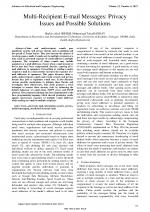| 4/2021 - 13 |
Multi-Recipient E-mail Messages: Privacy Issues and Possible SolutionsSHEIKH, S. A. |
| Extra paper information in |
| Click to see author's profile in |
| Download PDF |
Author keywords
electronic mail, information security, privacy, unified messaging, unsolicited electronic mail
References keywords
email(11), link(8), spam(6), smtp(6), mail(6), protocol(5), security(4), network(4), detection(4), approach(4)
Blue keywords are present in both the references section and the paper title.
About this article
Date of Publication: 2021-11-30
Volume 21, Issue 4, Year 2021, On page(s): 115 - 126
ISSN: 1582-7445, e-ISSN: 1844-7600
Digital Object Identifier: 10.4316/AECE.2021.04013
Web of Science Accession Number: 000725107100013
SCOPUS ID: 85122251585
Abstract
Chain and multi-recipient e-mails pose significant security and privacy threats such as phishing and the spread of Trojan horses. They also increase the chances of receiving spam e-mails. E-mails sent to multiple recipients at a time result in unwanted exposure of e-mail address to multiple recipients. The recipients of chain e-mails may include spammers or e-mail addresses of users whose e-mail account or device may have been compromised, thereby, exposing all e-mail addresses to spammers. Forwarding or sending a multi-recipient e-mail in a chain further increases the exposure of e-mail addresses to spammers. This paper discusses chain e-mails, multi-recipient e-mails and crucial security and privacy threats they pose to legitimate e-mail user. It also discusses various possible mechanisms to mitigate these threats and investigates their effectiveness. This study proposes a novel technique to counter these security risks by enhancing the default behaviour of e-mail client, SMPT server and SMTP protocol. The proposed technique has been implemented in the Java programming language which showed promising results against unnecessary exposure of multiple e-mail addresses while sending an e-mail to multiple recipients. |
| References | | | Cited By |
Web of Science® Times Cited: 1 [View]
View record in Web of Science® [View]
View Related Records® [View]
Updated today
SCOPUS® Times Cited: 2
View record in SCOPUS® [Free preview]
View citations in SCOPUS® [Free preview]
[1] Protecting Android Devices From Malware Attacks: A State-of-the-Art Report of Concepts, Modern Learning Models and Challenges, Bayazit, Esra Calik, Sahingoz, Ozgur Koray, Dogan, Buket, IEEE Access, ISSN 2169-3536, Issue , 2023.
Digital Object Identifier: 10.1109/ACCESS.2023.3323396 [CrossRef]
Disclaimer: All information displayed above was retrieved by using remote connections to respective databases. For the best user experience, we update all data by using background processes, and use caches in order to reduce the load on the servers we retrieve the information from. As we have no control on the availability of the database servers and sometimes the Internet connectivity may be affected, we do not guarantee the information is correct or complete. For the most accurate data, please always consult the database sites directly. Some external links require authentication or an institutional subscription.
Web of Science® is a registered trademark of Clarivate Analytics, Scopus® is a registered trademark of Elsevier B.V., other product names, company names, brand names, trademarks and logos are the property of their respective owners.
Faculty of Electrical Engineering and Computer Science
Stefan cel Mare University of Suceava, Romania
All rights reserved: Advances in Electrical and Computer Engineering is a registered trademark of the Stefan cel Mare University of Suceava. No part of this publication may be reproduced, stored in a retrieval system, photocopied, recorded or archived, without the written permission from the Editor. When authors submit their papers for publication, they agree that the copyright for their article be transferred to the Faculty of Electrical Engineering and Computer Science, Stefan cel Mare University of Suceava, Romania, if and only if the articles are accepted for publication. The copyright covers the exclusive rights to reproduce and distribute the article, including reprints and translations.
Permission for other use: The copyright owner's consent does not extend to copying for general distribution, for promotion, for creating new works, or for resale. Specific written permission must be obtained from the Editor for such copying. Direct linking to files hosted on this website is strictly prohibited.
Disclaimer: Whilst every effort is made by the publishers and editorial board to see that no inaccurate or misleading data, opinions or statements appear in this journal, they wish to make it clear that all information and opinions formulated in the articles, as well as linguistic accuracy, are the sole responsibility of the author.



